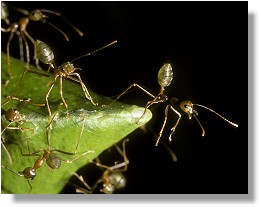
Copyright David Paul, University
of Melbourne.
Fee free license image
|
The green tree ant belongs to the ant genus Oecophylla
(subfamily Formicinae) which consists of only two species;
O. longinoda and O. smaragdina. Oecophylla smaragdina
is found in the tropical coastal areas in Australia as far south
as Rockhampton and across the coastal tropics of the Northern Territory
down to Broome in West Australia. Green ants are also often referred
to as weaver ants because of their ability to weave leaves together
to form nests bound with silk produced by their larvae. Most of
the nest construction and weaving is conducted at night with major
workers weaving towards the exterior of the nests and minor workers
weaving within the interior.
A mature colony of green tree ants can hold as many
as 100,000 to 500,000 workers and may span as many as 12 trees and
contain as many as 150 nests. Green ant colonies have one queen
and a colony can live for up to eight years. Minor workers usually
remain within the egg chambers of the nest tending the larvae, whereas
major workers defend the colony territory, assist with the care
of the queen and forage.
Mimetic relationships between
spiders and ants
Chemical Mimicry
Several species of spider live with green ants such
as the salticid spider Cosmophasis bitaeniata. Salticid spiders,
or jumping spiders, as they are sometimes referred to, have excellent
eyesight and are only active during daylight, weaving a protective
silken cocoon to spend the night in. Interestingly, this spider
does not look like green ants but instead it chemically mimics green
tree ants.
|

